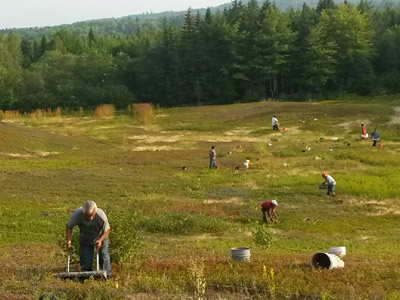Home → Labor Laws → Maine Monitor Advocate → 2015 Migrant Worker Survey - Introduction
Maine Migrant and Seasonal Farm Worker Demographic Survey
December 2015

I have lived in Maine my entire life, but this summer I quickly realized that so much of my home state is still unknown to me. When you grow up in Maine, you hear about the wild blueberries, the pine trees, and the lobster all the time, but what no one seems to know is that behind those iconic Maine products, there are groups of hardworking individuals who come from as far away as Florida, Texas, California, and Mexico to harvest and process these products for us. There is a migrant and seasonal farmworker (MSFW) population in Maine that consists of thousands of workers every year, and like so many others, I had no idea.
Fortunately, I had the opportunity to spend the summer of 2015 traveling to areas of the state I had never visited before, conducting a survey of these migrant workers. This experience was made possible through the Maine State Government Summer Internship Program operating through the Margaret Chase Smith Policy Center. Jorge Acero, State Monitor Advocate in the Maine Department of Labor's Bureau of Employment Services, developed the survey and supervised the project.
The survey itself consisted of two-and-a-half pages of questions and was conducted in both English and Spanish. I completed 52 surveys in total; 15 at the broccoli farms of Aroostook County and 37 in the wild blueberry barrens of Washington County. I surveyed a wide range of migrant workers from different cultures and backgrounds.
To conduct the survey, I approached these workers and asked them to sit down and share information about their lives with me. They received no direct benefits from speaking with me, but for the most part they were willing, and sometimes even enthusiastic, to talk to me about what they do. The survey covers family composition, living and working location prior to Maine, type of work prior to Maine, type of work while in Maine for each family member, anticipated destination post work in Maine, and similar questions. I asked them about where they come from, what work they do here in Maine and elsewhere in the United States, who they travel with, and more.
It took a lot of getting used to. The idea of approaching strangers, sometimes in their homes, sometimes during meals, and interrupting their day-to-day activities was intimidating for me, and it was daunting for the workers I interviewed as well. By the end of the summer it did get easier, and I wish I could continue to meet and talk to the workers who will soon arrive for apples and wreaths as the year continues.
It is my hope that the results of this survey will serve to enlighten the people of Maine about the MSFWs who work here every year. There is a great amount of stigma attached to the idea of migrant farm workers in the United States. That being said, many people do not even have a full understanding of what constitutes a migrant worker. This project provides a more accurate sense of what these workers do and who they are. The findings show that a migrant worker can be of any gender, age, race, or nationality. The workers are all individuals, and each person I spoke with had a unique experience with migrant work.
This project has five components:
- Survey Results
- Population Statistics
- Survey Maps
- Migrant Worker Narratives
- Original Surveys
The first, Survey Results, is an Excel spreadsheet that compiles the responses of all the survey participants. The second, Population Statistics, is a sequence of pie charts that provide a visual aid for understanding the MSFW population in Maine. The data presented covers the age, gender, and nationality of the workers, as well as the different locations they live and work in Maine and the rest of the United States. A short analysis accompanies some of the pie charts to explain the results illustrated. The third component, Survey Maps, exists as a hard copy here but also as an interactive online tool. Along with the hard copy, there is information on how to access the map online.
Unlike the previous items, the fourth component, Migrant Worker Narratives, is more qualitative than quantitative. It is a series of narratives, eleven in total, focusing on the interviews and experiences of specific migrant workers. It is difficult to look at a spreadsheet or a pie graph and truly grasp the whole story. With the addition of the narratives, my hope is that we can better understand what it means to live and work as a migrant worker. Each of the 52 workers interviewed had their own story to tell, and the small handful that is featured in the narratives should allow a glimpse into some of those stories.
The last component of the project, Original Surveys, is the raw survey data. There are blank copies of the survey in both Spanish and English and the original copies of the 52 surveys conducted in the field. Surveys 1–16, with the exception of 6, were collected in broccoli, and surveys 17–52 were collected in blueberries. Although surveys were conducted under varying circumstances, and some have more detail than others, the notes all hold value and provide an idea of the interview process.
I can look back over all 52 of the surveys and recall my conversation with each migrant worker. I am honored to have been able to meet and talk to these hardworking individuals who bring so much to the state of Maine. This has been an eye-opening and rewarding project for me, and I couldn’t have asked for a better summer internship.